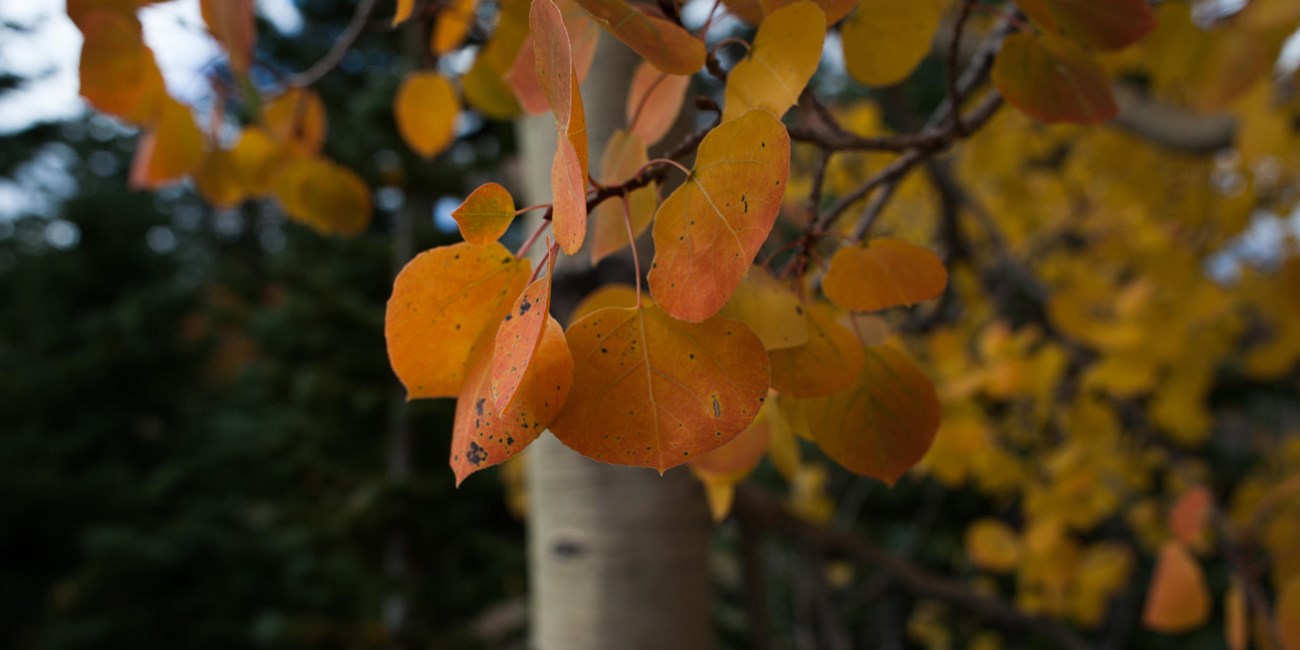
NPS Photo / Peter Densmore Common NamesQuaking Aspen, Trembling Aspen, "Quakies" Scientific NamePopulus tremuloides Size (height) English & Metric40-100 ft (12-30 m) tall HabitatMoist soils in openings or along edges of pine and spruce/fir forests Flowering SeasonMay & June but rarely flowers RangeFrom New England through Canada, into Alaska, and south into California, Arizona and New Mexico 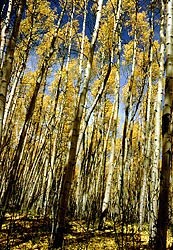
General DescriptionAspens can be identified by their smooth, white bark marked by black scars where lower branches are naturally self-pruned. Quaking Aspen leaves are somewhat heart shaped, with finely saw-toothed margins and range in size from 1.25-3" (3-8 cm) long. The leaves attach to branches via a long and flattened petiole, so that even the slightest breeze causes the leaves to flutter. This gives the overall tree the appearance that it is quaking or trembling - hence the common name Quaking Aspen and the scientific name's specific epithet - tremuloides. In the spring and summer, leaves are glossy green on the upper surface and dull green underneath. In the fall leaves turn yellow, gold, and in rare instances, even red. Quaking Aspens grow in large and dense colonies throughout North America enduring lows of -78° F and highs of 110° F. They prefer moist soil, but can grow near intermittent springs in desert environments that receive less then 7 inches of annual precipitation. The only absolute requirement for Quaking Aspen is lots of sunlight. 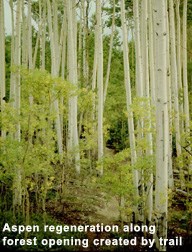
Plant LoreAspen are remarkable and unique trees. In fact they are so different that it may be better not to think of aspens as trees. First of all, a stand of aspen is really only one huge organism where the main life force is underground. Think of aspens as large 1-20 acre systems of roots that remain hidden underground until there's enough sunlight. Then the roots sprout up white things called trunks that then leaf off green things called leaves. This is called "vegetative" or asexual reproduction. Only after severe fire and under ideal climatic conditions, will aspen reproduce sexually as a flowering plant. 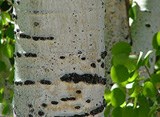
lee dittmann Conservation MessageBecause of their vegetative reproduction, aspens are in no danger of going extinct. Aspen forests will eventually become spruce and fir forests as the taller, more dense trees shade out the aspen underneath the canopy. However, even after 100 years or more, the dormant root system will spring back to life sprouting new trees once sunlight is allowed to reach the forest floor again. Therefore, forest fires, no matter how severe, encourage the growth of new aspen trunks in the asexual process also known as "root suckering." 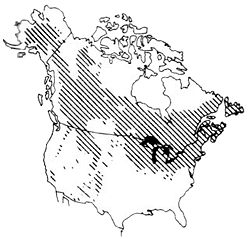
When and where to see at BryceThe above-ground portions of Quaking Aspens are few and far between at Bryce Canyon National Park. Historic photographs show that these kinds of forest used to be much more common. The aggressive suppression of forest fires, (natural or otherwise) has allowed spruce and fir forests to overshadow the once common aspen groves. Using prescribed fires to burn away key portions of the spruce and fir forests will allow aspen to quickly return to their former glory as a keystone species that assures the survival of many other kinds of plants and animals. Look for little pockets of aspen along the scenic drive at the southern end of the park and also tucked underneath the canyon rim between Sunset and Sunrise Points. Further ReadingBuchanan, Hayle 1992. Wildflowers of Southwestern Utah. Bryce Canyon Natural History Association. Bryce Canyon, Utah |
Last updated: February 1, 2023
